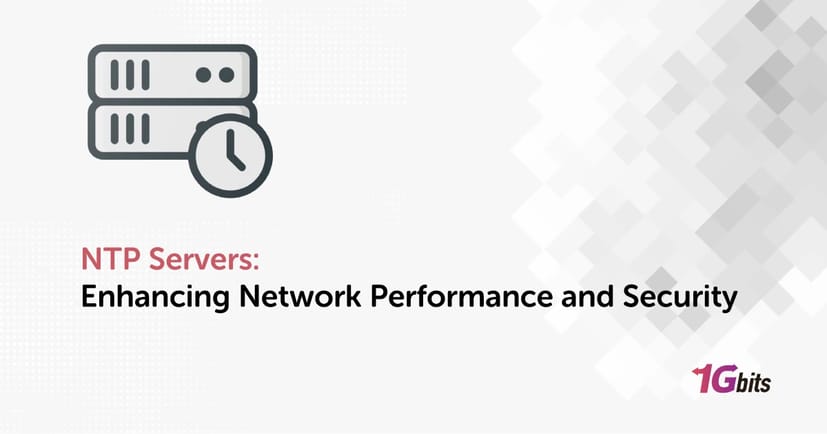In today's interconnected world, precise timekeeping is crucial for various applications ranging from network operations to scientific research. The Network Time Protocol (NTP) plays a fundamental role in synchronizing the clocks of computers over a network. In this article, we delve into the concept of NTP servers, their significance, and practical applications.
What is NTP Server and How it Works?
An NTP server is like the timekeeper of a digital world, making sure all the devices in a network stay in sync. It relies on a super accurate clock, often connected to something like an atomic clock or GPS, which acts as the main reference for time. This reference clock sets the pace for everything else.
Imagine it as a chief conductor leading an orchestra. At the top is the reference clock, the master of time, guiding the whole ensemble. Below are the Stratum 1 servers, like lead musicians following the main clock's lead. Then come the Stratum 2 servers, syncing up with the Stratum 1 servers.
This hierarchy continues down, with each level taking cues from the one above. The NTP server uses smart algorithms to adjust each device's clock so they all stay perfectly in time.
Here's how it works:
-
Reference Clock Source: Picture the top of the NTP hierarchy as the king of clocks, super accurate and reliable.
-
Stratum 1 Servers: These are like the main players in the band, directly connected to the top clock. They take their cues from the top clock.
-
Stratum 2 Servers: Next in line are these servers, syncing their time with Stratum 1. They follow the lead of the first group.
-
Stratum 3 and Beyond: The hierarchy keeps going down, with each level getting its time from the one above, like a cascade of music.
This keeps all the gadgets on the network perfectly synced up, making sure everything runs smoothly and keeps accurate time.
What is NTP Server in Networking?
An NTP server in networking is the cornerstone of keeping time in digital systems. It acts as a central hub for synchronizing the clocks of devices across a network. Think of it as the conductor of an orchestra, ensuring all the instruments play in perfect harmony. By distributing a consistent time signal, the NTP server ensures that network operations, data transactions, and security protocols function smoothly and accurately.
What is NTP Server Example?
An example of an NTP server could be a university's network infrastructure. Within the university's network, there may be a dedicated server responsible for synchronizing the time across all devices, such as computers, servers, and even digital clocks.
For those of you asking what is NTP server in Linux, this NTP server ensures that students, faculty, and staff all have access to accurate and synchronized time information for their academic and administrative activities.
What is NTP in Biology?
NTP, or Nucleoside Triphosphate, is a crucial molecule in biology, serving as an energy carrier in cellular processes. It plays a central role in activities such as DNA replication, transcription, and protein synthesis. Essentially, NTP provides the energy needed for these fundamental biological processes to occur, ensuring the proper functioning and survival of cells.
Google NTP server IP
Google provides public NTP servers that anyone can use to synchronize their devices' clocks. While the actual URL for NTP server Google is time.google.com, most servers can't handle a canonical domain name like time.google.com. Instead, they use the following IP addresses:
-
time.google.com: 219.239.35.0
-
time2.google.com: 219.239.35.4
-
time3.google.com: 219.239.35.8
-
time4.google.com: 219.239.35.12
These IP addresses ensure accurate time information for precise timekeeping across various systems and applications. By accessing Google's NTP server by IP address, users can ensure that their devices maintain accurate time synchronization.
What is NTP Server Used for?
An NTP server plays a crucial role in making sure all devices in a network have the same accurate time. This is important for:
Network Operations: Keeping time in sync helps network protocols run smoothly. It ensures that data moves efficiently, reducing delays and making networks work better.
Data Integrity: Time stamps keep data organized and reliable. NTP makes sure all devices use the same time, preventing mix-ups that could mess up data.
System Logs: Time stamps help track when things happen in a system. NTP ensures these time stamps are consistent across devices, making it easier to troubleshoot problems and spot security issues.
Distributed Systems: When operations happen across many servers, having the right time is crucial. NTP keeps everything in order so processes run correctly and data stays consistent.
Legal and Compliance: Some industries need precise time stamps to follow rules and prove what happened and when. The best NTP server ensures time stamps meet these rules, making them reliable for legal purposes.
Benefits of Using NTP Servers
Some people ask what is the best NTP server to use. To find out, you need to be aware of its advantages of first:
1. Enhanced Security: NTP helps safeguard systems against viruses and hacking attempts, unlike internet time servers which may expose systems to security risks by requiring open NTP server ports through firewalls. While internet time servers create potential vulnerabilities by opening firewall ports, NTP maintains system security without requiring such measures.
2. Prevention of Spoofing: You might be asking what is ntp server and client. NTP employs authorization techniques like shared encrypted passwords between client servers, mitigating the risk of spoofing, a common cyber threat. Unlike protocols reliant on the UDP protocol for client-server communication, NTP's authorization methods enhance security and prevent unauthorized access.
3. Greater Accuracy: NTP ensures precise time synchronization through symmetrical network communication, correcting minute time differences between clients. Stratum 1 NTP server time sync, utilizing GPS/GNSS satellite technology, maintain high accuracy levels.
4. Easy Configuration: NTP servers offer simple configuration and installation processes, allowing network administrators to fully control server settings. This ease of configuration reduces the likelihood of misconfigured clocks.
5. Improved Reliability and Availability: Unlike internet time servers, NTP servers offer greater reliability and availability, even in the absence of stable internet connections. By deploying redundant NTP servers, organizations can ensure continuous time synchronization and mitigate the impact of hardware failures.
Challenges and Limitations of NTP Servers
Despite its advantages, Network Time Protocol (NTP) faces several challenges that deter its widespread adoption. These challenges include:
1. Limited Security Options: The security features in NTP, like symmetrical encryption and asymmetric authentication, are often impractical and insecure. Symmetrical encryption relies on weak algorithms like MD5, while asymmetric authentication is based on the vulnerable Autokey protocol.
2. Persistent Spoofing Risks: NTP servers are susceptible to spoofing attacks, especially during system startup or when manipulated by attackers using techniques like time skimming. Current precautions are insufficient to address these risks effectively.
3. UDP Fragmentation Vulnerabilities: Attackers can exploit NTP servers by inserting fake fragments into fragmented UDP streams, potentially altering the delivery time without detection.
4. Kiss-Of-Death (KoD) Attacks: KoD, initially designed to mitigate denial-of-service (DoS) attacks, can be maliciously used to suspend client queries for extended periods, disrupting server functionality.
5. Time-Dependent Security Protocols: Security protocols in NTP are time-dependent, making servers vulnerable to DoS attacks or cache flushing by prematurely expiring TTLs. Adjusting system time to counteract this can leave servers susceptible to replay attacks.
How to Check NTP Server in Windows
To check the NTP server Windows settings, you can follow these steps:
-
Open Command Prompt: Press the Windows key, type "cmd", and press Enter to open Command Prompt.
-
Run Command: In the Command Prompt window, type the following command and press Enter:
w32tm /query /status
-
View Results: This command will display information about the Windows Time service, including the NTP server it's syncing with (if any), the time source, and its status.
Alternatively, you can use the following command to list the configured NTP servers:
w32tm /query /peers
This command will show an NTP server list for your Windows system is currently synchronized with, if any.
Public NTP Servers vs. Local NTP Servers
The choice between public and local NTP servers depends on factors like accuracy, security, and organization size. Public NTP servers offer accessibility to millions of users, usually for free, but their reliability and security can vary. In contrast, local NTP servers provide greater control, accuracy, and security, as organizations configure them according to their needs.
While setting up local servers incurs initial costs, it reduces reliance on external servers, mitigates security risks, and optimizes network performance. These qualities make it a beneficial choice for larger organizations requiring precise time synchronization.
How to Setup an NTP Server on Windows 10
Syncing your network devices with an internal NTP server helps keep time accurate across all systems. Here's a simple guide on how to do NTP server configuration:
1. Enable the Windows Time service:
-
Open the Services console by typing "services.msc" in the Run window (Windows Key + R).
-
Look for the Windows Time service under Standard Services.
-
Click on it, set the Startup type as Automatic, and click Start to activate the service.
2. Enable the NTP server in the Windows registry:
-
Open the Windows registry by typing "regedit" in the Run window (Windows Key + R).
-
Navigate to Computer\HKEY_LOCAL_MACHINE\SYSTEM\CurrentControlSet\Services\W32Time\TimeProviders\NtpServer.
-
Click on the Enabled entry and change the value data from 0 to 1.
3. Check the NTP configuration:
-
Open the command line and enter the command: "w32tm /query /configuration".
-
If the NTP server is not enabled yet, the output will indicate so.
4. Restart the Windows Time service or update W32tm:
-
Restart the Windows Time service enabled in step 1.
-
Alternatively, update W32tm from the command line using the command: "w32tm /config /update".
Your NTP server is now running, and you can direct all nodes on your network to the NTP server address and port of the machine.
Also if you want to learn How to set the Date and Time on Linux, read our guide.
Final Words
NTP, or the Network Time Protocol, is like the clock that keeps everything in sync on networks around the world. It's super important for making sure everything runs smoothly, from daily operations to big scientific projects. But, like anything, it's not perfect. There are some challenges, especially when it comes to keeping things safe from hackers and other security threats. However, with the right setup and know-how, organizations can use NTP to make their networks work better and be more dependable. We talked about all of these topics in detail, we hope you find it helpful.












